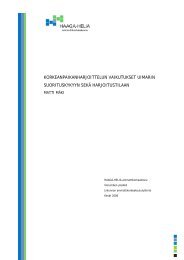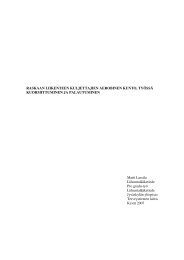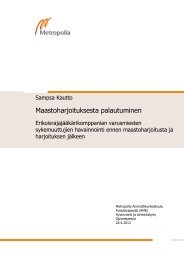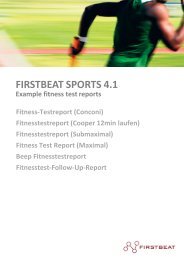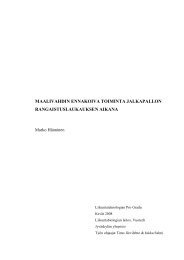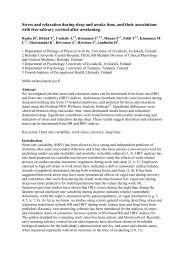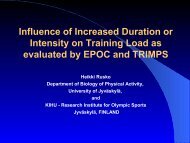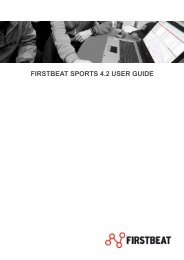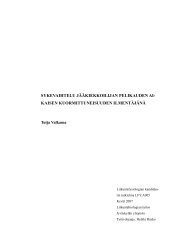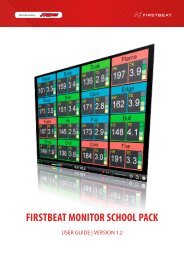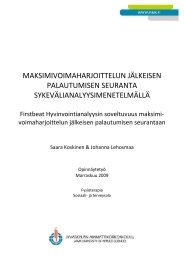Download. - Firstbeat
Download. - Firstbeat
Download. - Firstbeat
You also want an ePaper? Increase the reach of your titles
YUMPU automatically turns print PDFs into web optimized ePapers that Google loves.
Validation of Heart Rate Monitor-Based Predictions of Oxygen... : The Journal of Stre...<br />
http://journals.lww.com/nsca-jscr/Abstract/2009/08000/Validation_of_Heart_Rate_M...<br />
Page 1 of 2<br />
24/12/2009<br />
Journal of Strength and Conditioning Research:<br />
August 2009 - Volume 23 - Issue 5 - pp 1489-1495<br />
doi: 10.1519/JSC.0b013e3181a39277<br />
Original Research<br />
Validation of Heart Rate Monitor-Based<br />
Predictions of Oxygen Uptake and Energy<br />
Expenditure<br />
Montgomery, Paul G; Green, Daniel J; Etxebarria, Naroa; Pyne,<br />
David B; Saunders, Philo U; Minahan, Clare L<br />
Abstract<br />
Montgomery, PG, Green, DJ, Etxebarria, N, Pyne, DB, Saunders, PU, and Minahan,<br />
CL. Validation of heart rate monitor-based predictions of oxygen uptake and energy<br />
expenditure. J Strength Cond Res 23(5): 1489-1495, 2009-To validate Vȯ 2 and<br />
energy expenditure predictions by the Suunto heart rate (HR) system against a first<br />
principle gas analysis system, well-trained male (n = 10, age 29.8 ± 4.3 years, Vȯ 2<br />
65.9 ± 9.7 mlkg -1 min -1 ) and female (n = 7, 25.6 ± 3.6 years, 57.0 ± 4.2 mlkg -1 min -1 )<br />
runners completed a 2-stage incremental running test to establish submaximal and<br />
maximal oxygen uptake values. Metabolic cart values were used as the criterion<br />
measure of Vȯ 2 and energy expenditure (kJ) and compared with the predicted values<br />
from the Suunto software. The 3 levels of software analysis for the Suunto system<br />
were basic personal information (BI), BI + measured maximal HR (BI hr ), and BI hr +<br />
measured Vȯ 2 (BI hr + v ). Comparisons were analyzed using linear regression to<br />
determine the standard error of the estimate (SEE). Eight subjects repeated the trial<br />
within 7 days to determine reliability (typical error [TE]). The SEEs for oxygen<br />
consumption via BI, BI hr , and BI hr + v were 2.6, 2.8, and 2.6 mlkg -1 min -1 ,<br />
respectively, with corresponding percent coefficient of variation (%CV) of 6.0, 6.5,<br />
and 6.0. The bias compared with the criterion Vȯ 2 decreased from -6.3 for BI, -2.5<br />
for BI hr , to -0.9% for BI hr + v . The SEE of energy expenditure improved from BI (6.74<br />
kJ) to BI hr (6.56) and BI hr + v (6.14) with corresponding %CV of 13.6, 12.2, and 12.7.<br />
The TE values for Vȯ 2 were ∼0.60 mlkg -1 min -1 and ∼2 kJ for energy expenditure.<br />
The %CV for Vȯ2 and energy expenditure was ∼1 to 4%. Although reliable, basic HRbased<br />
estimations of Vȯ 2 and energy expenditure from the Suunto system<br />
underestimated Vȯ 2 and energy expenditure by ∼6 and 13%, respectively. However,<br />
estimation can be improved when maximal HR and Vȯ 2 values are added to the<br />
software analysis.<br />
© 2009 National Strength and Conditioning Association<br />
You currently do not have access to this article.<br />
You may need to:
Validation of Heart Rate Monitor-Based Predictions of Oxygen... : The Journal of Stre...<br />
http://journals.lww.com/nsca-jscr/Abstract/2009/08000/Validation_of_Heart_Rate_M...<br />
Page 2 of 2<br />
24/12/2009<br />
• Register an account.<br />
• Login if you are a registered subscriber.<br />
• Subscribe to this Journal , or<br />
• Purchase access to this article if you are not a current subscriber.<br />
• View this article in Ovid if your institution subscribes to this journal.<br />
Note: If your society membership provides for full-access to this article, you may need to<br />
login on your society’s web site first.



